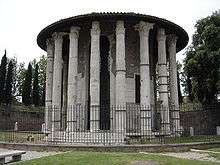Place of worship
The
Great Mosque of Kairouan, also called the Mosque of Uqba, in
Tunisia, was built in 670 and is the oldest and most prestigious Islamic place of worship in North Africa.
[1]The
Parthenon in
Athens, Greece, was built for the goddess
Athena in 447–432 BC and remained devoted to her cult for nearly a thousand years, later serving as a Christian church and then as an Islamic mosque under the
Ottoman Empire.
A place of worship is a specially designed structure or consecrated space where individuals or a group of people such as a congregation come to perform acts of devotion, veneration, or religious study. A building constructed or used for this purpose is sometimes called a house of worship. Temples, churches, and mosques are examples of structures created for worship. A monastery, particularly for Buddhists, may serve both to house those belonging to religious orders and as a place of worship for visitors. Natural or topographical features may also serve as places of worship, and are considered holy or sacrosanct in some religions; the rituals associated with the Ganges river are an example in Hinduism.
Under International Humanitarian Law and the Geneva Conventions, religious buildings are offered special protection, similar to the protection guaranteed hospitals displaying the Red Cross or Red Crescent. These international laws of war bar firing upon or from a religious building.
Religious architecture expresses the religious beliefs, aesthetic choices, and economic and technological capacity of those who create or adapt it, and thus places of worship show great variety depending on time and place.
Buddhism
Christianity
The word church derives from the Greek ekklesia, meaning the called-out ones. Its original meaning is to refer to the body of believers, or the body of Christ.[2] The word church is used to refer to a Christian place of worship by some Christian denominations, including Anglicans and Roman Catholics. Other Christian denominations, including the Religious Society of Friends, Mennonites, Christadelphians, and some unitarians, object to the use of the word "church" to refer to a building, as they argue that this word should be reserved for the body of believers who worship there.[3] Instead, these groups use words such as "Hall" to identify their places of worship or any building in use by them for the purpose of assembly.
Classical antiquity
Ancient Greece
Ancient Rome
Hinduism

Hindu mass prayer in
Ganges river.
Islam
Jainism
Judaism
- Synagogue – Judaism
- Some synagogues, especially Reform synagogues, are called temples, but Orthodox and Conservative Judaism consider this inappropriate as they do not consider synagogues a replacement for the Temple in Jerusalem. Some Jewish congregations use the Yiddish term 'shul' to describe their place of worship or Beyt Knesset ( Hebrew בית כנסת ) meaning house of assembly.
Norse Paganism
Shinto

Japanese people praying.
Sikhism
Taoism
Zoroastrianism
- Fire temple - All Zoroastrian temples fall into the Fire temple category.
Vietnamese ancestral worship
.jpg)
Cao Dai temple
See also
References
- ↑ Hans Kung (2006), Tracing the Way: Spiritual Dimensions of the World Religions, Continuum International Publishing Group, p. 248.
- ↑ "The New Testament Definition of the Church". Retrieved 23 June 2009.
- ↑ Gee, Matthew (8 May 2009). "Meeting for Church Affairs". The Friend (London, UK) 167 (19): 8. ISSN 0016-1268.
- ↑ ^ Robinson, James. Religions of the World: Hinduism.1st. Chelsea House Publishers, 2004. Page 72. ^ Werner, Karel (1994). A Popular Dictionary of Hinduism. Curzon Press. ISBN 0-7007-1049-3. ^ a b c Narayanan,Vasudha. "The Hindu Tradition". In A Concise Introduction to World Religions, ed. Willard G. Oxtoby and Alan F. Segal. New York: Oxford University Press, 2007 ^ Bain, Keith, Pippa Bryun, and David Allardice. Frommer’s India. 1st. New Jersey: Wiley Publishing, 2010. Page 75 ^ Harley, Gail M (2003). Hindu and Sikh Faiths in America. Facts on File, Inc. ISBN 0-8160-4987-4. ^ http://www.mandir.org/awards&opinions/Buildings%20and%20structures.htm
Further reading
- James P. Wind, Places of worship: exploring their history, Rowman Altamira, 1997
- Vaughan Hart, Places of worship, Phaidon, 1999
- Eric Kang, The Place of Worship, Essence Publishing, 2003
.jpg)

.jpg)



_in_Amritsar%2C_India.jpg)
.jpg)

